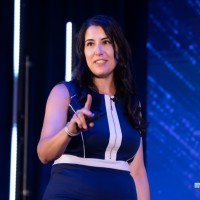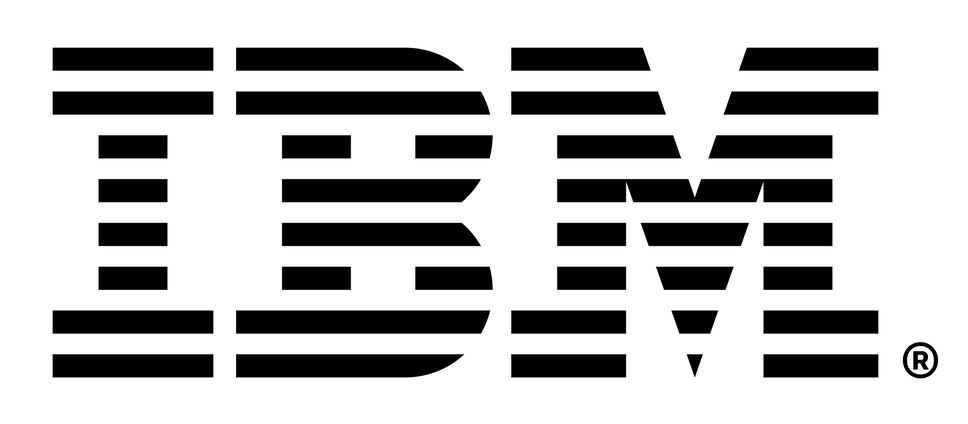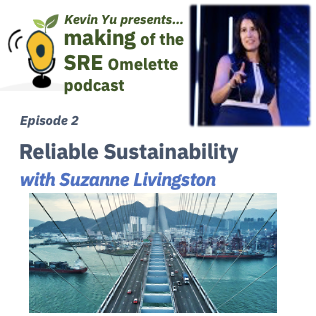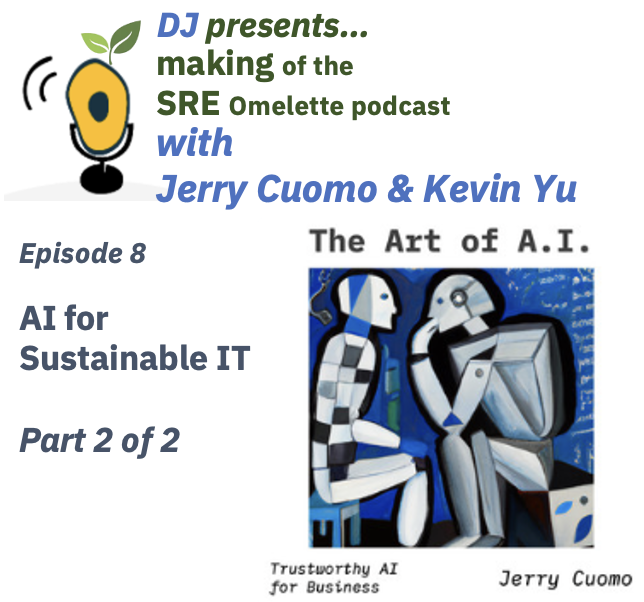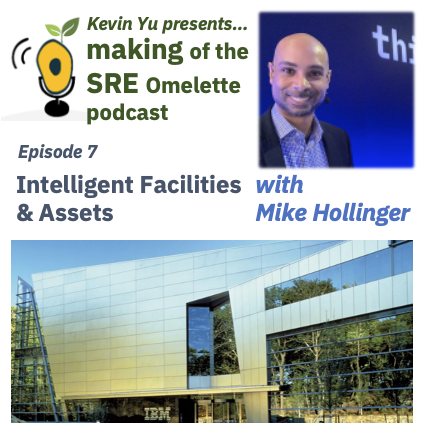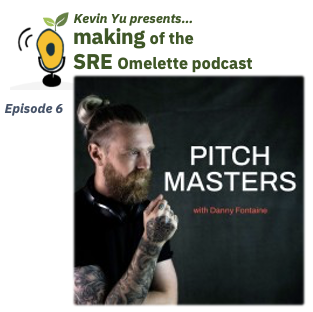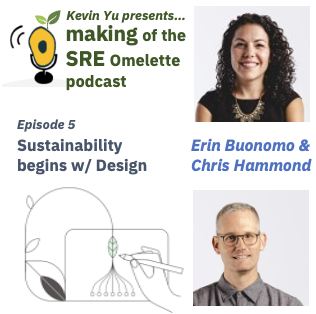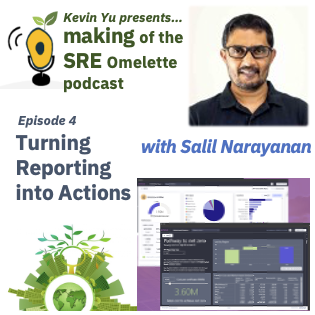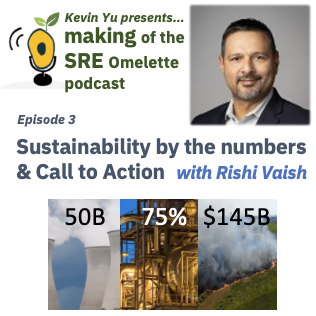Episode 2 - Reliable Sustainability
- 0.5
- 1
- 1.25
- 1.5
- 1.75
- 2
Suzanne Livingston: Well, we have technologies that will help you provision just what you need in time, but we also have to take responsibility in how we design software so that we can monitor, so that we can adjust, so that we can dynamically scale based on what the demand is. In all, it really starts with right at the beginning, what are you coding and what can you deliver into your software that you're developing and designing to help enable monitoring down the road, help enable dynamic scaling, help enable automation so that later you're not paying for that.
Kevin Yu: Hi, everyone. Welcome back to another episode of the Making of the SRE Omelette podcast, where we talk about how we achieve business and client success via the practice of site reliability engineering. Season two is all about how the practice of SRE can play a big part in helping and leading us to a more sustainable future. Sustainability is no longer just an ambition. Over the last few years, we are starting to see companies actively doing things and changing their behaviors to be more sustainable. Here to talk about how we make it real, operationalize what we talked about is Suzanne Livingston. Suzanne is the VP of Development and Reliability Engineering in IBM Sustainability Software. I'm so excited to have her here with us today. Welcome to the show, Suzanne.
Suzanne Livingston: Thank you for having me, Kevin. It's a pleasure to be here.
Kevin Yu: Suzanne, guests may think I made up your title. It is a perfect fit for this podcast, Reliability Engineering and Sustainability. Can you start by sharing with the audience your role?
Suzanne Livingston: Absolutely. It is a great opportunity to share what we're doing at IBM in sustainability, but also a little bit about what we do in reliability engineering. Yes, I am at the intersection of those two things. So let me just start with what we're doing at IBM. IBM has a whole area of software called IBM Sustainability Software, and it is a collection of products and services that help companies operationalize their sustainability missions. So think about in the enterprise asset management space where you have physical assets that you're monitoring and want to keep performance. Think about your real estate assets and portfolios. Think about how much square footage you're taking up, how much electricity you're using, can also think about transactions and our supply chains and how they interact with each other. There's a broad set of technologies. We also brought on board last year a technology that is focused on sustainability goals and reporting. It's called Envizi. That really adds a layer of being able to see visibly through your organization where you are from a sustainability standpoint. So those are all the products in my portfolio. As a VP of Engineering, we develop the products. As VP of Reliability Engineering, we run the products for our customers as well. We have our own managed services, our own SaaS services that clients can rely on us to run for them. We need to make sure that we're constantly keeping those systems performant, up to their expectations, meeting our SLAs, SLOs, and keeping ahead of what clients need from us from a capacity standpoint. So we both provide sustainability software and we also apply sustainability practices to the work that we do so that it's the most efficient.
Kevin Yu: Wow, that sounds like a dream place to be. Not only be able to help businesses achieve their sustainable goals, but also actively utilizing the tools and finding ways to make them more reliable, more efficient while doing it. So, Suzanne, I'm very curious to hear what does sustainability mean to you?
Suzanne Livingston: Let me start with the concept of sustainability first and then I'll dive into how we make that real in reliability engineering. If you think about the last few years, sustainability has become a really hot topic globally. We at IBM have, as I mentioned earlier, we have a portfolio of technologies that addresses different needs, whether it's environmental, like how do I reduce carbon footprint and environmental impact of my company's operations, for example. We have technologies to help address that. How do I prepare for impacts of climate change? We have technologies to help with that mission as well. Or from a social perspective, how do I create a safe, positive, equitable workplace for my employees? How do I ensure that the supply chains I'm reliant on align with my ethical values? Or how does my company deliver inclusive and positive impact for our broader ecosystem? Then from the governance standpoint, how do I build a governance structure that's auditable and compliant, help me achieve my ESG goals? These are all areas where our customers are coming to us with questions about how to do that. We're both in the position of providing guidance as well as technology support for the sustainability journey. I mentioned earlier, we brought in a technology last year that act as a system of record for all ESG data in an organization, measure it, report it, operationalize it, and then help visualize how that data is getting you to achieve your sustainability goals on the roadmap. So that's in part the type of client environment that we're working with. I think a lot of the reason why constant companies are coming to us now and what's different than in the past is that now companies are being asked by their investors to prove that their sustainability practices are working. They're being asked by compliance boards to provide sustainability metrics and data to show that they're progressing. I think there is less of a desire to buy your way out of making real substantive changes to your operations, meaning less focus on buying carbon offsets and more focus on actually reducing emissions, actually putting in place practices. So the context of sustainability is growing. Now how does that relate to reliability engineering? Well, a lot of the companies that we work with, they choose to work with us in one of two ways. They'll either take our software and run it themselves, so they'll have their own data centers. They'll run our technology, they'll provide support for it to their organizations. For them, they want to know that what they're running is also contributing it positively to their ESG requirements. So have we built into the product using software architecture examples that can show that we're not over consuming resources, that we're not over driving their electricity usage, for example. So that's for those who are running on- prem. Then there's others who are leveraging our services, what we provide for software as a service or managed services. They want to know how efficient are these running because they're also a consumer of these technologies and they're also responsible for the output. So in that regard, are we not only do we have software architecture in let's say efficiency in how we code, but also in our operations, are we monitoring our systems? Are we automating our systems? Are we running at a capacity that's reasonable for the expected use? Then how about our data centers? Are they monitoring and optimizing high consumption services? So from a customer standpoint, they want to know that our practices overall, our practices and architecture and engineering and coding and operations are well aligned to where they want to go because ultimately they're responsible too for reporting out on their usage, their carbon impact, and their usage of technologies that run in various clouds. So I think right now what we are focused on is being able to reduce waste in our practice. That means being tight about what we prioritize and focus on. That means ensuring we have quality right up front, that our products are serviceable from the start, monitoring automation. We don't provision too much, we don't provision too little. It's like Goldilocks provisioning. We've got to get it just right so that way we're not overconsuming or putting our customers in a position of not being able to meet their needs. So we set a bar pretty high on our SLAs and then our goal is to meet that SLA consistently for our clients.
Kevin Yu: It is interesting you mentioned Goldilocks provisioning, to have just the right amount of capacity to meet the needs of the customer. Suzanne, it is much easier to just over- provision to be on the safe side, isn't it?
Suzanne Livingston: Your example there of over- provisioning is so common today. We see this with so many of our clients. Let's be frank about it. The risk associated to under- provisioning means real dollars for organizations, especially during peak seasons. We just ended our holiday season, which runs from November to January. Sure, many of our clients will over- provision systems. The reality is that does end up being the default behavior for a lot of organizations culturally, they're set to act in that way. We have technologies too that IBM provides, like our Turbonomic software that will help you provision just what you need in time. We also have to take responsibility in how we design software so that we can monitor, so that we can adjust, so that we can dynamically scale based on what the demand is and also so that we can predict the demand better. We have enough data now so that way we can tell when a client is going to expect peaks and be able to readjust our software for handling those peaks and readjust our infrastructure to handle those peaks as well. So I think in all it really starts with right at the beginning, what are you coding and what can you deliver into your software that you're developing and designing to help enable monitoring down the road, help enable dynamic scaling, help enable automation so that later you're not paying for that.
Kevin Yu: That is a great capture. I especially like how you said we have to be responsible to build solutions that can take advantage of dynamic scaling from day one. Once the problem is in the field, it is much more costly and sometimes impossible to mitigate. It really goes towards the mindset that reliability engineering is everyone's job, not just a point in time activity.
Suzanne Livingston: 100%.
Kevin Yu: Suzanne, talk of sustainability is new, was there a collective aha moment that led to companies and organizations to take it much more seriously now?
Suzanne Livingston: I think a couple things are driving attention. I mentioned earlier, compliance. The SEC earlier last year made some comment that went around in news articles that they were going to start requiring companies to submit their sustainability data just as they do their financial data. So think of financial grade reporting for your sustainability metric. A lot of companies are tracking sustainability metrics, but what they're doing is they're collecting it manually. They're using spreadsheets, it's not accurate. When it comes to financial grade reporting that there's a much higher level of rigor and auditability that's required. At least here in the US, once that went out, a lot of companies immediately turned and said, " IBM, we know that you have an investment and sustainability software and consulting practices. Can you help us?" Our number one thing that we did was we laid out how they can begin getting on a reporting journey, starting with laying out with their goals, helping them enable them to track a baseline of those metrics related to their goals so that they could start putting this together. The technologies that we have enable them to do that easily. So I think the SEC in regulatory bodies is one, and there are regulatory bodies in Europe who are also pushing for more high grade inaudible reporting related to the sustainability goals and metrics. I think the other thing that happened a few years ago, I want to say it was 2020, Black Rock had even said publicly that one of the key criteria they're looking for in companies that they invest in are their sustainability measurement and goals. How well are they achieving them? So you see now financial analysts, you see funds, you see investments, you see investments going into companies who are providing either sustainability related consulting, technology, or are providing sustainable products and services. So that's driving a lot of focus around sustainability from companies' boards who are asking where do we stand on this from your company's investors. Then I think the other piece that probably has been with us for some time, consumer awareness of sustainable products and wanting to invest in products that are sustainable. You can go into a store today without seeing sustainable references either in the branding of products or in references to them. You can go into ecommerce site and not see reference and you can search on sustainable products. Now you can filter based on them. So I think about as many different reports out there, but many of them reference about 66% of consumers would be willing to pay more for sustainable products and services than before. That's a huge driver and for demand. So you see a lot of desire to bring, not only do the great work of reducing your carbon impact, but share that you did with your customer base to drive more consumer demand. So all these three areas that regulatory financial investors and consumers driving companies down this pathway, which is fired up by the need to actually produce a report.
Kevin Yu: Thanks for the insight, Suzanne. I'm always curious of how people and companies are influenced to change and what you share is a perfect combination that explains the actions. Now speaking of actions, can you touch on what IBM has done to be more sustainable?
Suzanne Livingston: I'll share with you a couple of customer examples and then also want to take this opportunity to share with you a new paper that we just put out there last week. It's called IBM Software Engineering for Sustainability. I have a link to it in my LinkedIn profile.
Kevin Yu: I can add it as a link on the podcast as well.
Suzanne Livingston: Oh, perfect. Thank you. One question we get is, as a software engineering firm or as a software operations provider, what should we be doing for our own practices? So this is a point of view that we just put out that shares our impact practices in software development, in software operations, and how we make software accessible and support multiple languages for global impact, ethical impact of our practices, the role of hybrid cloud in sustainability, role of AI in sustainability when it comes, and this is a big space, and comes to model training, when it comes to model development, and when it comes to AI ethics and transparency and models. Then of course the role of open source and measuring software sustainability. I think the beginnings of this really talk about our software engineering principles. So conservation, reducing energy and carbon usage, statically and dynamically, reducing the footprint of computing, memory, networking and storage, simplifying the topology through every transaction that has to run across our systems and data transportation back and forth that ends up adding to your carbon output. So how to simplify that, design for efficiency, balance resource constraints. So this paper goes into a lot more than that, but it's a good starting point for getting you thinking about, well, where can I make substantive changes to how our processes run, how our teams run, the culture of our teams, what we care about when it comes to development and operations. I think from a customer standpoint, a couple different examples I'll share with you. One, I'll give you a link too to include in the notes, company Celestica. They're a organization that's held up as a strong sustainability company. They lead and design manufacturing and supply chain solutions. They have 20, 000 employees globally. They operate 50 sites across 15 countries. They provide product life cycle services and product design services, but they are known to be focused on sustainable impact. We worked with them using our ESG suite Envizi. They were looking to pull together data from across all of those sites to be able to show that they have what their impact was on their sustainability metrics. Things like a 21% decrease in greenhouse gas emissions, 10, 000 metric tons of carbon equivalent averted, almost 19, 000 employees who have taken a sustainable workspace pledge. So how do you get those numbers? You have to collect data and they had been collecting data manually and through spreadsheets and aggregating this for our tooling. So we came in, we worked with them on getting them to adopt Envizi and now they're able to collect data all around the world from different units and compile it automatically. They input it into Envizi ESG suite and have it transformed immediately into usable outputs. Every time they update it, they immediately see the impact on their metrics. So it helps them reduce errors, it helps them manage their data, and it saves them time on how much reporting steps go along with that. So that's one of our customers doing that immediately, just getting their data and collecting it. I think another action is how do I think about transforming my operations to better support sustainable goals? We have a company that we work with, Sund & Bælt. I'll also share with you a link. They have a great case study. They have one of the largest bridges in the world and they were able to double the lifespan of that bridge from a hundred years to 200 years. By doing that, you think, well, what's the impact on the planet for that? 750, 000 tons of carbon emissions in the process of rebuilding a bridge. So by extending that bridge's lifespan, they're saving a ton, like 780,000 of them of emissions into the world. So it's practices like that. How did they do it? It's not just simply by implementing a tracking software. They're actually using our Maximo application suite to monitor the bridge's condition continuously, using drones that are deployed to examine the bridge for cracks. We have AI models that are part of the suite that gives them a view of the change of a crack over time or any other type of structural issue that would cause them to take action immediately, deploy someone to go fix, to go address it rather than wait until it becomes a structural problem. Before, they were deploying mountaineers to go climb the bridge, inspect the bridge end to end manually. That takes months of effort, how much dollars included in that. Also, the safety and health risk too, the people whose role it was to go do that. Now they're able to do that on a much more frequent basis and extend the bridge's lifetime. So different kinds of examples of what you can do from getting a baseline, just knowing where you're at and then to actually changing the way in which you work in order to better accommodate. That's from an engineering perspective with the case study and then a bridge engineering perspective with Sund& Bælt.
Kevin Yu: Suzanne, as you capture the examples, it is very much related to the outcome of SRE to reduce tools, right? Anything from using tools for reporting to eliminate spreadsheets and PowerPoints, to having automated drones to eliminate manual activities for dangerous inspections. Suzanne, I think you may have just inspired many listeners to want to achieve those wonderful outcomes you shared in the success stories. What would be your advice for them to get started?
Suzanne Livingston: I think a good starting place is looking at the sustainable development goals from the UN. They open your mind as to areas where you could be focused on making real tangible impact. Then a lot of it is just starting with what you have and what you've done. Before you go and map out your whole plan, just take a look at your baseline. What has your organization been focusing on to date and what are the impacts of those actions? It sounds simple, but many organizations can't do this because they require manual data collection, because they don't have visibility into the data. So simply starting with something like our ESG tooling that will allow you to collect up could be as simple as data from utility bills all the way through to key programs that you've put in place and how you're tracking them. Get a view of that across all your sites and now you have a starting point. Then you can really tweak the goals that you have and see if those goals are making an improvement. For example, putting in place a target, putting in place some actions related to that target and then see if those actions have an impact. With continuous data reporting, you'll know fairly quickly whether those actions have an impact. So I think starting with the baseline, setting the ambitions and then assessing the impact of them. Of course IBM can help you on that journey. We have a consulting organization can help from laying out what the foundation of your sustainability strategy should be. We also have the software organization to provide the technologies to do that with intelligent assets and facilities and infrastructure, with responsible computing and IT, and also with sustainable supply chain software all tied into our ESG platform. So, happy to address questions and more than happy to have folks reach out if they need help getting started.
Kevin Yu: That is a great set of starting points and I'm going to steal a line from one of my previous guests, Jerry Cuomo. He said, " AI eats data for breakfast." Very much aligned with what you said of having that baseline to give us the information to know where we are as well as what to prioritize on.
Suzanne Livingston: Sustainably.
Kevin Yu: Yes, definitely. Thank you for the clarification. So we get to the segment of the show that touches on tech vitality. I'm curious of your thoughts here, given your role leading both the engineering and the SRE organizations. What will be your advice for site reliability engineers wanting to contribute to our sustainability efforts?
Suzanne Livingston: When I think of vitality, I think of one of the programs that you run, which I don't mean to put you on the spot. I'll share it from my perspective, which is I think there's a lot of creative ideas that people have about how best to improve their operations to support sustainability goals, change the way that we are building our software or running our software to address our sustainability goals. A lot of times these ideas don't get heard because they're not connected to the overall missions of an organization. Something that you did last year, which I thought was a great way to get connected to the great ideas of the organization, is to run a jam where teams can self form and go prototype out an idea that they have and show the impact of that idea potentially for inclusion into our products, into our services or inaudible, just our culture and how we operate. To me, that opened up the door to the whole organization to be a part of defining how we move forward from a sustainability perspective, not just a tops down, only coming from strategic layer, but also from the day- to- day work that we do. So I would say that was a phenomenal success. I've already seen impact into the way that we run our teams. I would recommend something like that for any organization who wants to get going on, well, what are the key things that we should be starting with and where can we get some immediate impact? So well done there.
Kevin Yu: Oh, thank you so much, Suzanne, for the kind words. I was very happy with the engagement we had. We had submissions across the organization, found different products and rules and people really captured what they thought would be better based on their own experiences working with the solution as well as with the customer. Definitely a great way to engage a team and naturally having that diverse perspective for great innovation. So thank you so much for the shout out there, Suzanne.
Suzanne Livingston: Yeah, for sure. I think some great ideas came out of that. There was a team, I think, who submitted ideas on how to proactively predict that there were going to be issues with a client's deployment and address them immediately. That has a sustainability impact. If you think about it, the amount of waste that goes into handling an issue that could have been addressed up front. So in cases like this, these are things that we may have missed from a strategic standpoint that actually turned into real actionable results on the team side.
Kevin Yu: I'm so glad you remember that submission. Let me perhaps expand it a little for the audience. We may often think responsible computing for SRE is right sizing provision, just what we need. Well, that is a big problem we see and we talked about earlier in the show. What that submission looked at was how can we proactively stay ahead of incidents that may lead to people getting paged, customers opening tickets. The ability to prevent incidents from happening in the first place can have a tremendous impact on reducing processing required to mitigate.
Suzanne Livingston: Also think of all the human intervention required in order to address it that may take people away from other activities more helpful for them to be on. So there's two sides to it too.
Kevin Yu: For sure. Events like Shark Tank are fun. Speaking of fun, Suzanne, we have arrived at the final question. This goes back to the inspiration of the podcast, Making of the SRE Omelette, that culture and behavior is the outcome of what we do. So in the context of the chicken or the egg, it is like an omelette. Suzanne, what would be your ingredient and recipe for companies to turn their sustainability ambition into action and reality?
Suzanne Livingston: I think I would one, start with what you have. Know where you're at now, and yeah, that's an activity that will drive a lot of awareness in where you need to improve. So once you know where you are, then set ambitions. What are you going to try to get to by when? How are you going to do it? Engage your team support and work backwards from that vision. So if you're setting a ambition of being net- zero by a certain date, set the milestones that you're going to take to get there, the locations, who's involved, what systems are affected, what processes are affected, how are you going to collect data, what's changing. All of that. Work backwards. So start with what you have. Set big ambitions and work backwards.
Kevin Yu: That is a very practical recipe I think everyone can follow to turn their sustainability ambition into a reality. Suzanne, thank you so much for spending the time with us today.
Suzanne Livingston: Thank you so much for having me. It's been a pleasure.
Kevin Yu: I also like to thank you, the audience, for listening as well. See you on a future episode where we continue the discussion to surface how reliability engineering can help us arrive at a sustainable future.
DESCRIPTION
Sustainability is no longer just an ambition, over the last few years, we’re starting to see companies actively doing things and changing their behaviours to be more sustainable.
Suzanne Livingston, VP of Development & Reliability Engineering at IBM Sustainability Software takes the audience through the journey of building a solution that is reliable and sustainable from day one. She also shares insights on why Sustainability is the focus of companies today, success stories with customers she has worked with and what IBM is doing to help their customers to achieve sustainability goals.
Lastly, Suzanne gives practical advices on how companies and organization can get started right away and take steps closer to realizing their sustainability goals.
Today's Host
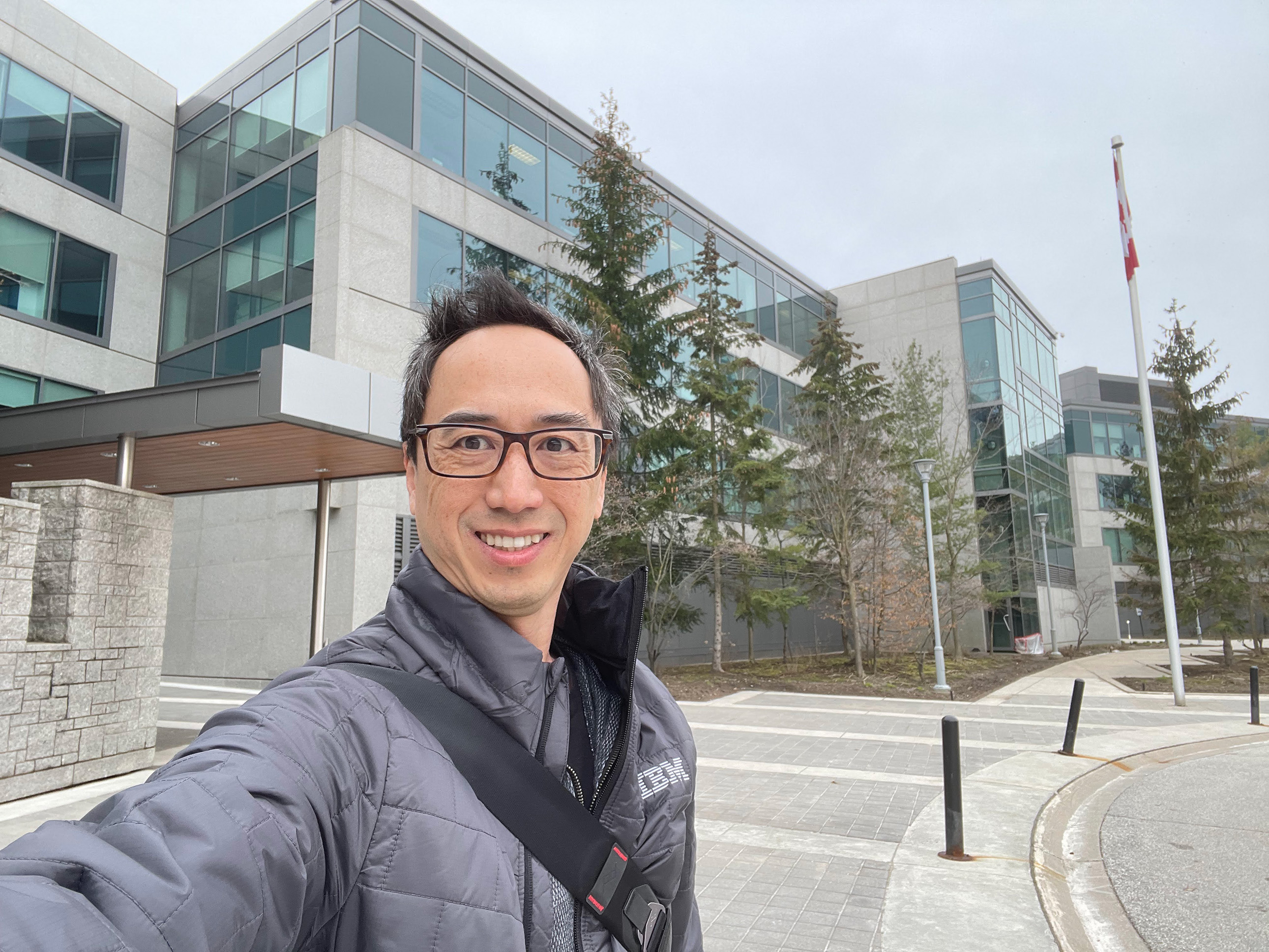
Kevin Yu
Today's Guests
